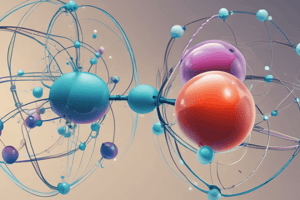Podcast
Questions and Answers
Which type of overlapping of atomic orbitals forms a σ bond?
Which type of overlapping of atomic orbitals forms a σ bond?
- Out-of-phase combination
- Lateral overlap
- Head-to-head overlap (correct)
- In-phase combination
What type of combination of atomic orbitals may form a σ bond?
What type of combination of atomic orbitals may form a σ bond?
- s-p and p-p orbitals
- s-s, s-p, and p-p orbitals (correct)
- s-s and p-p orbitals
- p-p and s-s orbitals
Which type of molecular orbital is more stable than both antibonding molecular orbitals and parent atomic orbitals?
Which type of molecular orbital is more stable than both antibonding molecular orbitals and parent atomic orbitals?
- Bonding orbital (correct)
- Antibonding orbital
- Parent atomic orbital
- π orbital
What is the electron density like in antibonding molecular orbitals?
What is the electron density like in antibonding molecular orbitals?
What is the main difference between bonding and antibonding orbitals?
What is the main difference between bonding and antibonding orbitals?
In molecular orbital theory, what type of bond is formed when atomic orbitals intersect in a sideways positive direction perpendicular to the internuclear axis?
In molecular orbital theory, what type of bond is formed when atomic orbitals intersect in a sideways positive direction perpendicular to the internuclear axis?
How are sigma (σ) and pi (π) bonds formed in relation to each other?
How are sigma (σ) and pi (π) bonds formed in relation to each other?
What are the characteristics of pi* (π*)-orbitals in molecular orbital theory?
What are the characteristics of pi* (π*)-orbitals in molecular orbital theory?
What is the bond order for carbon (C2) based on its molecular orbital energies?
What is the bond order for carbon (C2) based on its molecular orbital energies?
What determines the stability of a resulting molecule in molecular orbital theory?
What determines the stability of a resulting molecule in molecular orbital theory?
Study Notes
Types of Bonds and Atomic Orbitals
- σ (sigma) bonds are formed by the head-on overlap of atomic orbitals.
- σ bonds can also form through the combination of two s orbitals, an s and a p orbital, or two p orbitals aligned end-to-end.
Stability of Molecular Orbitals
- Bonding molecular orbitals are more stable than both antibonding molecular orbitals and parent atomic orbitals.
- Antibonding molecular orbitals possess electron density concentrated outside the region between the nuclei, unlike bonding orbitals.
Bonding vs. Antibonding Orbitals
- The main distinction between bonding and antibonding orbitals lies in their electron density distribution and energy levels; bonding orbitals promote stability, while antibonding orbitals hinder it.
Molecular Orbital Interactions
- In molecular orbital theory, a bond is formed when atomic orbitals intersect sideways in a positive manner, leading to the creation of π (pi) bonds.
Relationship Between σ and π Bonds
- σ bonds are formed before π bonds; a σ bond must exist first, followed by the formation of π bonds through lateral overlaps.
Characteristics of π* Orbitals
- π* (pi star) orbitals are antibonding orbitals associated with π bonds; they have higher energy than the corresponding bonding π orbitals.
Bond Order Calculation
- The bond order for carbon in the C2 molecule can be derived from its molecular orbital energy levels and typically equals 2, indicating a double bond.
Stability of Molecules in Molecular Orbital Theory
- The stability of a resulting molecule is influenced by the bond order, with higher bond orders corresponding to greater stability, reflecting the balance of bonding and antibonding electrons.
Studying That Suits You
Use AI to generate personalized quizzes and flashcards to suit your learning preferences.
Description
Test your knowledge about bonding and antibonding orbitals in chemistry. Learn about the differences between the two types of orbitals and their roles in chemical bonding.



